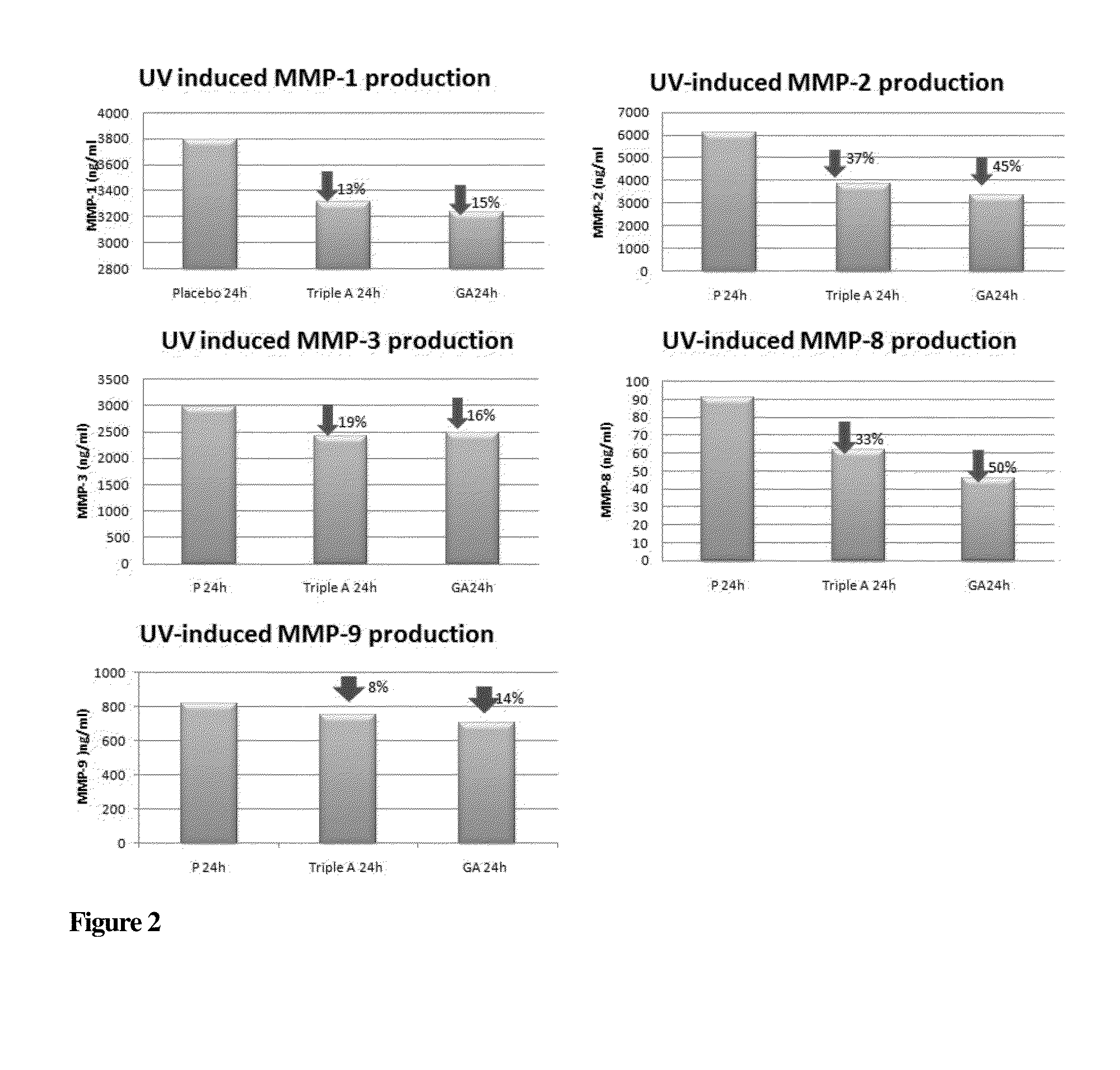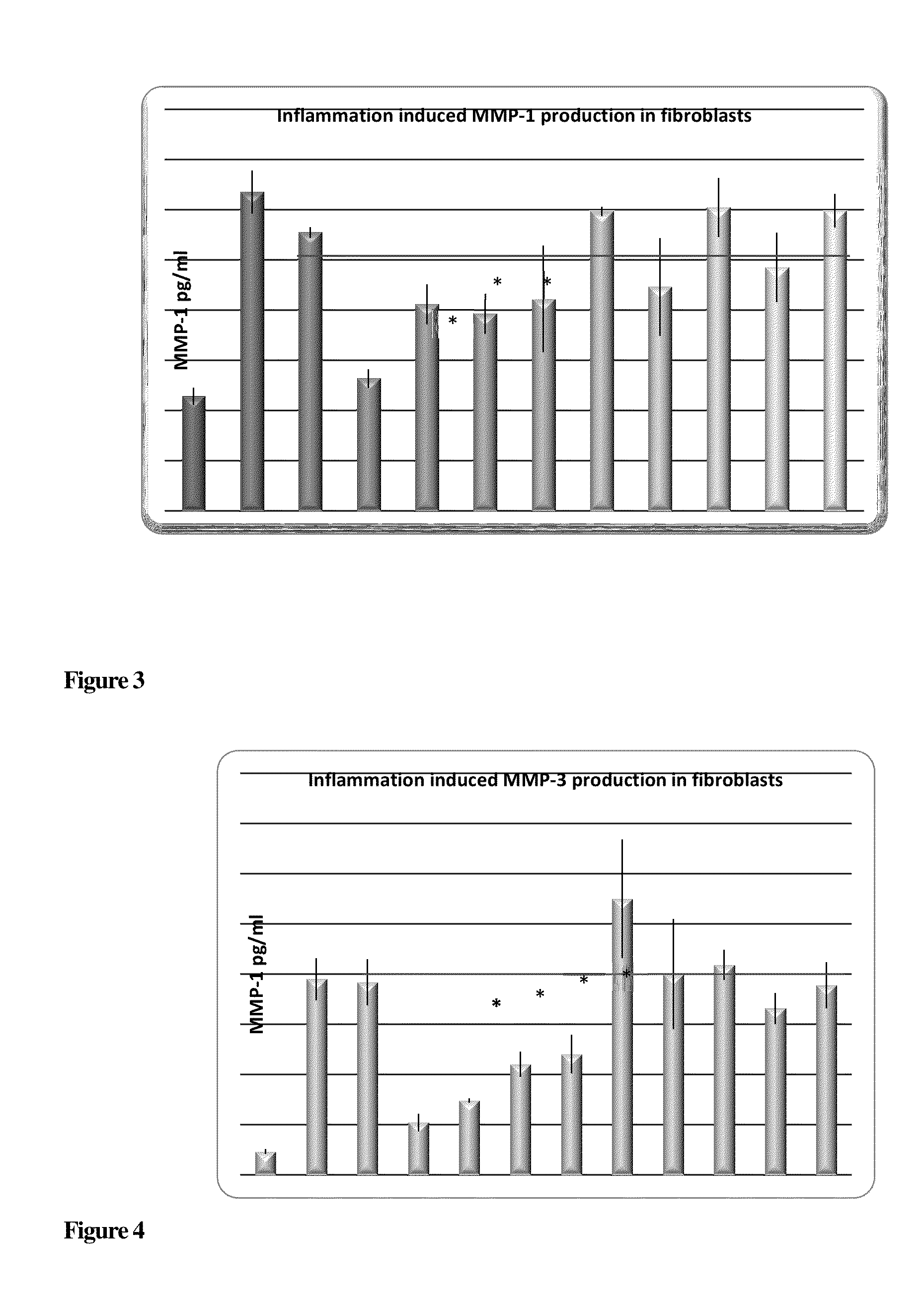Compounds with Anti-aging activities
a technology of compounds and active ingredients, applied in the field of compounds, can solve the problems of increased susceptibility of the skin to external insults, loss of moisture and ultimately to dry skin, and impaired barrier function, and achieve the effects of preventing or alleviating the formation of skin wrinkles and skin laxity, and healthy skin integrity
- Summary
- Abstract
- Description
- Claims
- Application Information
AI Technical Summary
Benefits of technology
Problems solved by technology
Method used
Image
Examples
example 1
Connectivity Mapping Approach Identifies Compounds with Retinoic Acid-Like Gene Regulation Behaviour
[0120]A connectivity mapping (Cmap) approach was used to identify retinoid-like compounds.
[0121]Gene expression profiling was performed on skin biopsies from healthy female subjects which were topically applied with tretinoin (all-trans retinoic acid) in a concentration of 0.025% (Retin-A® ex. Johnson & Johnson) for one week. Gene signatures obtained from the tretinoin treated skin were queried in the Cmap database. Compounds identified which ranked highly in the Cmap were topically applied on skin explants received from breast plastic surgery. Gene arrays were repeated on the treated samples 24 hours after topical application.
example 1.1
Materials and Methods
[0122]Treatment of Skin with Tretinoin
[0123]Skin biopsies were taken from sun-exposed forearms of 8 healthy Caucasian female subjects, aged 50+ years. Patients were treated with tretinoin (Retin-A® concentration 0.025%) for one week. At the end of the week 3 mm punch biopsies were taken from each site of treatment. The study was vehicle controlled. Two biopsies were taken per treatment, per arm, for sufficient RNA concentration. Biopsies were immediately stored under controlled conditions at 4° C. for 24 hours prior to RNA extraction.
Treatment of Skin Explants with Tretinoin
[0124]Subcutaneous fat from full thickness skin, obtained from surgical waste material from breast reduction procedures, was removed with a scalpel. Three healthy Caucasian female donors were used for this study, aged 23, 41 and 60 years. The female donors differed from those of the skin-treatment study outlined previously 8 mm punch biopsies were taken from the skin (and these biopsies are n...
example 1.2
Results—Identification of Compounds with Gene Signatures Mimicking Retinoic Acid
[0129]The findings from the Cmap analysis connected the gene signature of retinoic acid-treated human skin to novel potential compounds with the ability to mimic the activity of retinoic acid.
[0130]Many genes were individually shown to be regulated by all-trans retinoic acid. Due to the intervariable differences in the patient material from the explants study and clinical study, separate approaches were taken. The gene expression profiles in biopsies after all-trans retinoic acid treatment compared with vehicle-treated controls were examined by DNA microarray analysis.
[0131]Two separate studies on gene expression profiles in human skin after topical application of all-trans retinoic acid were conducted. The first study was performed Ex vivo by topically applying all-trans retinoic acid for 24 hours on skin explants from 3 donors prior microarray conduction. The 2nd study was a clinical In Vivo study, top...
PUM
| Property | Measurement | Unit |
|---|---|---|
| Fraction | aaaaa | aaaaa |
| Fraction | aaaaa | aaaaa |
| Fraction | aaaaa | aaaaa |
Abstract
Description
Claims
Application Information
 Login to View More
Login to View More - R&D
- Intellectual Property
- Life Sciences
- Materials
- Tech Scout
- Unparalleled Data Quality
- Higher Quality Content
- 60% Fewer Hallucinations
Browse by: Latest US Patents, China's latest patents, Technical Efficacy Thesaurus, Application Domain, Technology Topic, Popular Technical Reports.
© 2025 PatSnap. All rights reserved.Legal|Privacy policy|Modern Slavery Act Transparency Statement|Sitemap|About US| Contact US: help@patsnap.com



